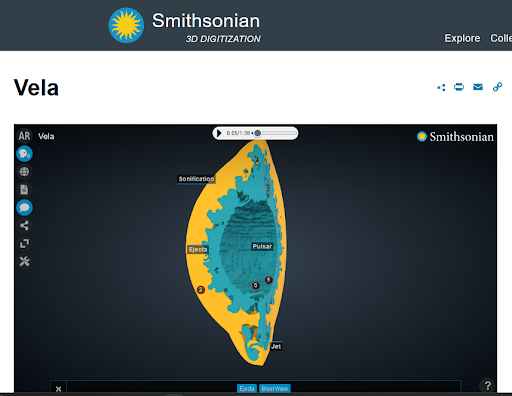Chandra and Voyager: A Robust 3D Experience

A screenshot from the Smithsonian Voyager 3D platform: Vela Pulsar is shown here with its ejecta and blast wave turned on. Explore the Vela sonification and visual description tour while tumbling around the 3D model and turning the ejecta and blast wave on and off. Download an stl model for 3D printing to hold the Vela Pulsar in your hand.
Credit: INAF-Observatorio Astronomico di Palermo/S.Orlando & NASA/CXC/SAO/A. Jubett et al; Smithsonian Institution/J. Cope, M. Dattoria et al;
The creative team at Chandra X-ray Center has been hard at work on a collaboration with the Smithsonian Institution’s Digitization Program Office (3D SI). Together, our teams have been bringing three-dimensional X-ray datasets to the Voyager platform to offer inclusive, multi-sensory learning experiences.
The Chandra X-ray Observatory is one of NASA's “Great Observatories” (along with the Hubble Space Telescope and the James Webb Telescope). Chandra, the world's most powerful X-ray telescope, is still going strong after 25 years in orbit. The Smithsonian Astrophysical Observatory (SAO) in Massachusetts operates the telescope and runs the science center on behalf of NASA.
In 2021, Chandra and 3D SI released a collection of cosmic models showing various high-energy phenomena in three dimensions including novas, supernovas, pulsars, and the Chandra telescope itself. These 3D representations provided the opportunity for users to tumble around each object and learn about its features and the science behind the model. This has been a huge step in granting greater access to these incredible 3D models and prints for institutions like libraries and museums, as well as the scientific community and individuals in the greater public.
To help celebrate Chandra’s 25 years of observations, we have added new items to our 3D collection and released new Instagram experiences in partnership with Smithsonian, NASA, and Brown University. This new release includes the latest model with improved accessibility features of the Vela Pulsar joining Chandra’s Voyager collection and improved accessibility features. The 25th Anniversary 3D release simultaneously debuts new Instagram experiences of the Vela Pulsar and four other objects, as well as to existing models of Tycho's Supernova Remnant and V745 SCO. These three objects are annotated with highlighted areas of interest, incorporating, for the first time on the Voyager platform, audio and text versions of Visual Description Tours, which walk the user through the details of the models, describing the textures and shapes and what they represent.
The Vela and Tycho datasets also include sonifications as one of the annotated features. A sonification is the translation of data into sound rather than colors, so that the user can explore the shape and texture of a phenomenon by listening. Sonifications and visual descriptions offer a way for the blind and low-vision communities to experience the datasets in new ways. The 3D printing also adds a tactile experience, building a robust multi-sensory process of learning and discovery.
All of Chandra’s 3D models are made freely available in 3D-printable formats, and anyone with access to a 3D printer or printing service can have the models built to hold in their hands.
Discover the Chandra X-ray Observatory’s Voyager collection at https://3d.si.edu/collections/Chandra. Explore all of the 3D SI collections in Voyager at https://3d.si.edu/collections, where exotic cosmic phenomena shown with X-ray and other data sit alongside the US Botanic Garden’s orchid collection, and Neil Armstrong’s space suit, to name just a few highlights of this treasure trove of 3D objects.
Please note this is a moderated blog. No pornography, spam, profanity or discriminatory remarks are allowed. No personal attacks are allowed. Users should stay on topic to keep it relevant for the readers.
Read the privacy statement
